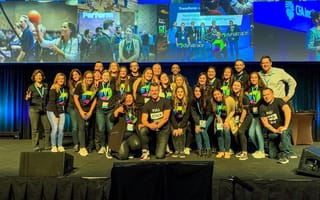At software intelligence company Dynatrace, the marketing team took a page from the engineering department’s playbook.
SVP of Marketing Dave Anderson said employees applied an autonomous team’s methodology to strategy development, wherein work is divided up by project rather than assigned based on role. This achieved two things, according to Anderson: it allowed team members to organically identify their position within the department and it broke down data silos that were responsible for unnecessary heavy-lifting across the whole company. Through shared ownership, each team and contributor now feels empowered to bring new ideas and challenge the status quo, Anderson added.
But breaking down data silos starts long before projects are assigned, Anderson said. It begins in the hiring process.
“We actively hire people who we think fit into a certain team-based culture and are open to continuous improvement,” Anderson said.
As he shakes a candidate’s hand, virtually or otherwise, Anderson is assessing their openness to constant change and frequent, candid communication. These strategies, as well as a suite of tech tools, allow Dynatrace marketers to test new features, track how people engage with their content, and of course, iterate.

What steps have you taken to break down data silos in your organization, particularly as it relates to your marketing efforts?
Dynatrace marketing has shifted quickly toward an autonomous team’s methodology. We took inspiration for this format from our software engineering department and our CTO. Where possible, we don’t follow a silo or functional team structure. Instead, we create work groups focused on tasks and projects. Team members organically identify their role in the project and report to a team captain.
We workshop and have stand-ups and project managers to keep us on track. We openly communicate about culture, what the autonomous team’s methodology should be about and how we can best achieve our goals. We actively hire people who we think fit into a certain team-based culture and are open to continuous improvement. We’re looking for candidates who have an ability to laugh at themselves when they make mistakes but are ultimately driven to make a difference.
What software or tech tools are you using to better integrate your customer data?
Our product has the ability to democratize data for broad teams to help them make fast decisions. We follow the same principles. We actually often benchmark what we market against our own marketing tech stack. For example, how does it improve productivity and get the answers we need without creating more work?
We use Dynatrace for digital experience and performance as well as Google Analytics, Marketo, Salesforce, Altryx and Tableau. Our reporting is mostly automated, which allows us to interpret and hypothesize, versus report out. We A/B test new features on websites using Dynatrace Session Replay, our digital experience monitoring solution, to see how people engage with our content. Then, we iterate. It’s fascinating and fun.
Each team and contributor feels empowered to bring new ideas, challenge the norm and find better ways to move forward.’’
Tell us about a big win you've experienced by breaking down these data silos.
Our annual customer event, Perform, is a company-wide initiative. It spans across countries and nearly every team in the business. Each year, Perform improves because we have established shared ownership. Each team and contributor feels empowered to bring new ideas, challenge the norm and find better ways to move forward. We actively plan a year in advance, which includes reflecting on previous years. Our organization makes me proud to be an executive team leader. I know I am just one player in a much bigger process.






